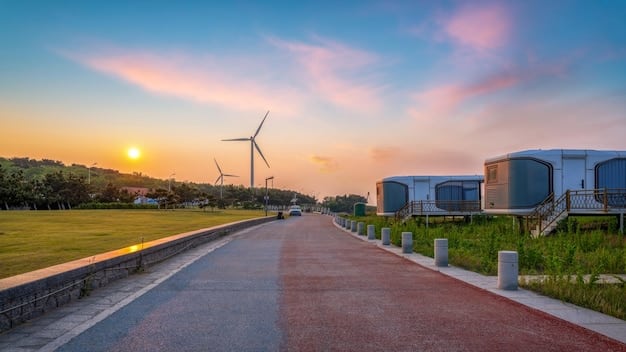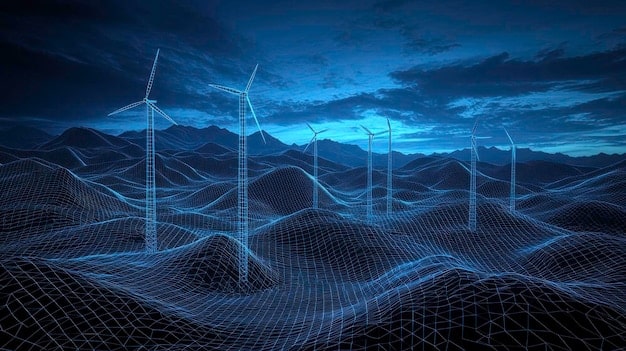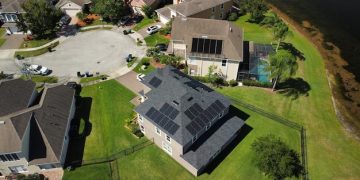US Renewable Energy Programs: 2025 Outlook

Looking ahead to 2025, the United States government continues to evolve its portfolio of programs and incentives, providing robust support for the widespread adoption of renewable energy technologies across residential, commercial, and industrial sectors, reflecting a concerted effort towards sustainability and energy independence.
As the global push for sustainability intensifies, understanding the evolving landscape of government support for clean energy becomes paramount. This guide explores what are the updated government programs supporting renewable energy adoption in 2025 in the United States, offering insights into how individuals, businesses, and communities can leverage these initiatives to foster a greener future and achieve significant energy savings. From new tax credits to expanded grant opportunities, the commitment to renewable energy is stronger than ever, signaling a pivotal moment for widespread adoption.
The Bipartisan Infrastructure Law and its Renewable Energy Impact
The Bipartisan Infrastructure Law (BIL), enacted in 2021, set a foundational stage for significant investments across various sectors, including renewable energy. While not exclusively focused on renewables, its provisions indirectly and directly bolster adoption through funding for grid modernization, energy efficiency, and clean energy technology deployment. In 2025, many of these programs are entering new phases, with expanded access and refined guidelines.
One critical aspect of the BIL is its allocation for grid infrastructure. A modernized, resilient grid is indispensable for integrating a higher percentage of intermittent renewable sources like solar and wind power. Funding specifically targets projects that enhance transmission capacity, improve grid reliability, and enable smart grid technologies that can manage fluctuating energy flows more efficiently. This foundational work is crucial for enabling the widespread adoption of renewables, ensuring that generated clean energy can reach consumers effectively.
It’s not just about direct deployment of solar panels or wind turbines; it’s about creating an entire ecosystem that supports their functionality and scalability. The BIL’s focus on energy storage solutions, for instance, directly addresses one of the primary challenges of renewable energy: intermittency. Investments in battery storage and other advanced energy storage technologies mean that excess energy produced during peak sunlight or wind can be stored and dispatched when needed, providing grid stability and making renewable sources more reliable.
Modernizing the Grid for Renewable Integration
The existing power grid in many parts of the U.S. was not designed to accommodate decentralized, intermittent renewable energy sources. Key initiatives under the BIL aim to bring this infrastructure into the 21st century.
- Grid Reliability and Resilience: Programs offering grants for projects that prevent outages and enhance transmission capabilities, crucial for handling diverse energy inputs.
- Smart Grid Technologies: Funding for advanced sensors, communication systems, and automated controls that optimize energy flow and integrate renewables seamlessly.
- Energy Storage Deployment: Significant investments in utility-scale and distributed energy storage projects to balance supply and demand.
These efforts underscore the understanding that isolated renewable energy projects, without a robust grid, cannot achieve their full potential. The synergy between infrastructure enhancements and clean energy deployment is a cornerstone of the 2025 strategy, creating a more stable and efficient environment for sustainable energy growth. The emphasis on resilience also includes protections against extreme weather events, further safeguarding energy infrastructure as climate change impacts become more pronounced.
Inflation Reduction Act (IRA) and its Enduring Incentives
The Inflation Reduction Act (IRA) of 2022 represents perhaps the most transformative piece of climate legislation in U.S. history, with profound implications for renewable energy adoption extending well into 2025 and beyond. Its core involves a suite of long-term tax credits and incentives designed to reduce the cost of clean energy technologies, making them more accessible and economically attractive for consumers and businesses alike. The IRA’s provisions are generally applicable for a decade, providing much-needed certainty for investments.
For homeowners, the IRA significantly expanded and extended the Residential Clean Energy Credit (formerly the Investment Tax Credit for homeowners), offering a 30% tax credit for the installation of new clean energy property, including solar, wind, geothermal heat pumps, and battery storage. This credit remains strong in 2025, continuing to reduce the upfront cost of adopting clean energy solutions, encouraging widespread residential uptake. The direct, tangible financial benefit makes renewable energy a more viable option for millions of households.
Key IRA Tax Credits and Direct Pay Options
The IRA provides a multi-faceted approach to incentives, encompassing various forms of clean energy.
- Residential Clean Energy Credit: A 30% tax credit for eligible clean energy equipment installed in homes.
- Clean Electricity Production Tax Credit (PTC): Incentivizes utility-scale renewable power generation based on electricity produced.
- Clean Electricity Investment Tax Credit (ITC): Offers a 30% credit for the cost of clean electricity generation facilities and energy storage.
Beyond the traditional tax credits, a notable innovation of the IRA is the introduction of “direct pay” and “transferability” provisions for certain entities, such as non-profits, municipal utilities, and rural electric cooperatives. This allows these entities to receive a direct cash payment equal to the value of the tax credit, even if they don’t have sufficient tax liability to claim the full credit. This is particularly impactful for organizations that previously couldn’t fully utilize tax credits, leveling the playing field and accelerating clean energy projects in communities that might otherwise lag.
The direct pay option, combined with the long-term certainty of the credits, serves as a powerful de-risking mechanism for clean energy investments. It opens up opportunities for a broader range of organizations to participate in the renewable energy transition, ensuring that the benefits of clean energy adoption are more equitably distributed across various community types and financial structures. This enduring framework provides predictable economic benefits, crucial for long-term planning and investment in renewable energy.
Department of Energy (DOE) Grant Programs and Initiatives
The Department of Energy (DOE) plays a pivotal role in advancing renewable energy through a combination of research and development (R&D), demonstration projects, and direct financial assistance via grants. In 2025, the DOE continues to manage and launch programs aimed at de-risking new technologies, fostering innovation, and deploying mature solutions to market. These grants often target specific challenges or opportunities within the clean energy ecosystem, complementing broader tax incentives.
One major area of focus for the DOE is accelerating the development and commercialization of emerging renewable technologies, such as advanced geothermal systems, marine energy, and next-generation solar technologies. Grants are often awarded through competitive solicitations, encouraging both academic research institutions and private companies to push the boundaries of what is technically and economically feasible. This ensures a pipeline of future renewable solutions that can further diversify the energy mix and drive down costs.
Targeted Grant Opportunities for Innovation and Deployment
The DOE’s grant portfolio addresses a spectrum of needs, from foundational research to large-scale deployment.
- Renewables Advancements: Funding for R&D into next-generation solar, wind, and geothermal technologies, aiming for higher efficiency and lower costs.
- Community Energy Programs: Grants supporting localized renewable energy projects, often with a focus on energy justice and equitable access.
- Industrial Decarbonization: Initiatives to help energy-intensive industries adopt renewable energy and energy efficiency measures.
Beyond technological advancements, the DOE also focuses on deployment assistance, particularly for underserved communities. Programs like the Energy Efficiency and Conservation Block Grant (EECBG) and various clean energy access programs provide direct funding to state, local, and tribal governments to implement clean energy projects, including renewable energy installations for public buildings, community solar projects, and energy burden reduction initiatives. These programs are vital for ensuring that the renewable energy transition benefits everyone, not just those with immediate access to capital or expertise. The strategic allocation of these grants helps to build capacity at the local level and address specific regional energy needs.

State and Local Government Incentives in 2025
While federal programs set a broad framework, state and local governments play a crucial role in tailoring incentives to specific regional needs and market conditions. In 2025, many states and municipalities continue to offer a diverse array of programs that complement federal support, ranging from tax credits and rebates to unique regulatory frameworks that encourage renewable energy adoption. These localized efforts often provide the critical push needed to make projects financially viable at the community level.
State renewable portfolio standards (RPS), for instance, mandate that a certain percentage of electricity sold by utilities must come from renewable sources. These standards often create market demand for renewable energy credits (RECs), providing an additional revenue stream for renewable energy generators. In 2025, some states are tightening their RPS targets or expanding eligible technologies, further driving investment in local renewable projects. These policy drivers are essential for creating a stable, long-term market for clean energy within state borders.
Beyond state-level mandates, many local governments are implementing their own incentive programs. These often take the form of property tax exemptions for renewable energy systems, streamlined permitting processes to reduce bureaucratic hurdles, or even direct rebates for specific technologies like solar panels or electric vehicle charging stations. These hyper-local initiatives are incredibly effective because they address specific barriers or opportunities within a community, fostering grassroots adoption and accelerating progress towards local energy goals.
Examples of Effective State and Local Support
The variety of state and local programs underscores their adaptability and responsiveness to local conditions.
- State Tax Credits and Rebates: Many states offer their own tax credits, often stackable with federal incentives, or direct rebates for renewable energy equipment.
- Net Metering Policies: These policies allow solar owners to sell excess electricity back to the grid, varying in structure and compensation across states.
- Property Assessed Clean Energy (PACE) Programs: Local programs enabling property owners to finance renewable energy improvements through property tax assessments.
- Streamlined Permitting: Efforts by local authorities to simplify and accelerate the approval process for renewable energy installations.
The dynamism of state and local policies means that the specific incentives available can vary significantly from one jurisdiction to another. Homeowners and businesses interested in adopting renewable energy should research the specific programs available in their state and local area. Often, a combination of federal, state, and local incentives can significantly reduce the overall cost of a renewable energy system, making the clean energy transition more economically appealing and achievable for a wider demographic.
Emerging Trends and Future Outlook for Renewable Programs
Looking beyond 2025, several emerging trends are likely to shape the future of government support for renewable energy adoption. The focus is shifting not only towards increasing renewable penetration but also towards optimizing their integration, ensuring grid stability, and addressing equity concerns. Innovation in energy storage, grid management, and carbon capture technologies will likely receive increased attention, complementing existing renewable initiatives.
One significant trend is the growing emphasis on energy storage solutions. As renewable energy sources like solar and wind constitute a larger share of the energy mix, the need for robust energy storage becomes critical to balance supply and demand. Government programs are expected to increasingly incentivize not just the deployment of renewable generation but also co-located or stand-alone storage, including battery storage, pumped hydro, and potentially even hydrogen-based storage solutions. This holistic approach ensures higher reliability and greater utilization of renewable energy.
Another key area is the focus on “energy communities” and environmental justice. Future programs are likely to direct more funding and support towards communities that have historically been reliant on fossil fuel industries or have been disproportionately affected by pollution. This includes initiatives for retraining workers, repurposing former fossil fuel sites for renewable energy projects, and ensuring that the economic benefits of the clean energy transition are shared equitably across all demographic groups.
Key Directions for Future Renewable Energy Support
Anticipated shifts in policy and program design reflect evolving energy needs and societal priorities.
- Advanced Storage Integration: Stronger incentives and R&D for diverse energy storage technologies.
- Hydrogen and Other Emerging Fuels: Continued investment in low-carbon hydrogen production and other innovative clean fuels for hard-to-decarbonize sectors.
- Workforce Development: Programs to train a skilled workforce for the growing clean energy sector, ensuring job creation and economic transition.
- Circular Economy Principles: Focus on sustainability throughout the lifecycle of renewable technologies, from manufacturing to recycling.
Finally, the role of digitalization and artificial intelligence (AI) in optimizing renewable energy systems is expected to grow. Government programs may begin to support the integration of AI-driven grid management systems, predictive analytics for renewable energy forecasting, and digital platforms that facilitate more efficient energy markets. These technological advancements will be crucial for managing an increasingly complex and decentralized energy grid, making renewable energy not only sustainable but also intelligently integrated and highly efficient. The long-term vision is a fully decarbonized, resilient, and equitable energy system.

Navigating the Application and Utilization Process
Understanding the existence of these government programs is only the first step; effectively navigating the application and utilization process is crucial to leveraging their benefits. Many programs, especially grants and tax credits, require specific documentation, adherence to eligibility criteria, and often, professional assistance. The process can seem daunting, but resources are available to guide potential applicants.
For individuals seeking residential tax credits, the primary step typically involves consulting with a reputable tax professional or using reliable tax software capable of handling energy credits. Keeping meticulous records of installation costs and project details is essential. For many, simply installing eligible equipment and claiming the credit on their annual tax return is straightforward, but understanding the specifics, like how the credit interacts with state incentives, can optimize financial benefits.
Businesses and non-profits pursuing larger grants or the direct pay option under the IRA often require a more robust approach. This frequently involves engaging with grant writers, energy consultants, or financial advisors who specialize in renewable energy development. They can assist with crafting compelling proposals, navigating regulatory requirements, and ensuring compliance with program guidelines. Many federal agencies also provide detailed guidance documents, webinars, and technical assistance to help applicants understand the process.
Key Steps for Accessing Renewable Energy Support
A structured approach can simplify the complex landscape of government incentives.
- Research Eligibility: Confirm that your project or household meets the specific criteria for federal, state, and local programs.
- Gather Documentation: Collect all necessary project details, financial records, and certifications.
- Seek Professional Advice: Consult tax advisors, energy consultants, or grant specialists, especially for larger projects.
- Stay Informed: Program details and availability can change; regularly check official government websites.
- Apply Strategically: Consider stacking incentives where permitted to maximize financial benefits.
Furthermore, several government websites and non-profit organizations offer comprehensive databases and tools to help users identify relevant programs. The Department of Energy’s Energy.gov website, for example, provides extensive information on federal programs, while resources like the Database of State Incentives for Renewables & Efficiency (DSIRE) offer a searchable platform for state and local incentives. Leveraging these resources, combined with professional guidance where needed, significantly enhances the likelihood of successfully accessing and utilizing these invaluable government programs, paving the way for broader renewable energy adoption across the United States.
| Key Program | Brief Description |
|---|---|
| 🏛️ Bipartisan Infrastructure Law | Funds grid modernization and infrastructure crucial for renewable energy integration. |
| 💰 Inflation Reduction Act | Extends significant tax credits (e.g., 30% for residential solar) and introduces direct pay options. |
| 🔬 DOE Grant Programs | Supports R&D, demonstration projects, and deployment of clean energy technologies. |
| 🏡 State & Local Incentives | Offer localized tax credits, rebates, and streamlined permitting to complement federal efforts. |
Frequently Asked Questions About Renewable Energy Programs
The primary benefit for homeowners from the Inflation Reduction Act (IRA) in 2025 is the extended 30% Residential Clean Energy Credit. This tax credit significantly reduces the upfront cost of installing eligible clean energy systems like solar panels, wind turbines, and geothermal heat pumps, making renewable energy more financially accessible and encouraging broader adoption across the U.S.
The Bipartisan Infrastructure Law (BIL) primarily supports renewable energy adoption by funding critical grid modernization and resilience projects. A robust, smart grid is essential for integrating intermittent renewable sources effectively. The BIL’s investments enhance transmission capacity, improve grid stability, and support energy storage, creating an indispensable foundation for widespread clean energy deployment.
Yes, federal grants are available for community-scale renewable energy projects, primarily through the Department of Energy (DOE). These programs often target specific needs, such as energy efficiency and conservation block grants for local governments or initiatives aimed at assisting underserved communities. They fund public buildings, community solar, and other localized renewable energy installations to foster equitable access.
In many cases, yes. State and local incentives, such as tax credits, rebates, and property tax exemptions, are designed to complement federal programs. Combining these incentives can significantly increase the overall financial benefit of installing renewable energy systems. However, it’s crucial for individuals and businesses to research specific program rules, as stacking rules and eligibility can vary by jurisdiction.
“Direct pay” under the Inflation Reduction Act allows certain tax-exempt entities, like non-profits, municipal utilities, and rural electric cooperatives, to receive a direct cash payment equal to the value of a clean energy tax credit. This is particularly beneficial for organizations that traditionally couldn’t utilize tax credits due to insufficient tax liability, ensuring broader participation in renewable energy development.
Conclusion
The landscape of government programs supporting renewable energy adoption in 2025 in the United States reflects a strategic, multi-layered commitment to a clean energy future. From the foundational infrastructure investments of the Bipartisan Infrastructure Law to the transformative financial incentives within the Inflation Reduction Act, coupled with targeted DOE grants and diverse state and local initiatives, the support framework is robust and comprehensive. Navigating these programs effectively requires understanding their specific applications, but the collective aim is clear: to accelerate the transition to sustainable energy, enhance grid resilience, and ensure that the economic and environmental benefits of renewable power are accessible to all. As these programs continue to evolve, they lay the groundwork for a more sustainable, energy-independent nation.





